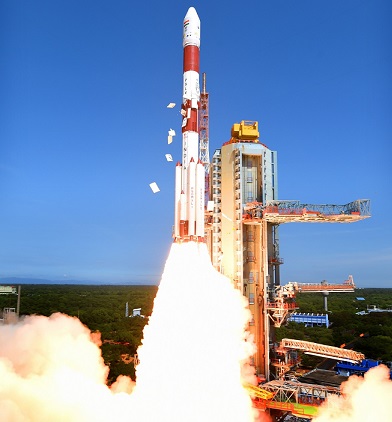
The PSLV-C34 rocket carrying a recond 20 satellites takes off from Sriharikota, Andhra Pradesh on June 22, 2016. An ISRO photo
By Ritu Mousumi Tripathy
India's great, grand space agency has achieved yet another magical milestone.
Since Aryabhata -- India's first indigenous satellite launched by a Russian (erstwhile Soviet Union) rocket from their territory of Astrakhan in the year 1975, the Indian Space Research Organisation (ISRO) has come a long, a very long way.
With the successful launch of a record number of 20 satellites at one go by its very own workhorse Polar Satellite Launch Vehicle (PSLV) on June 22, 2016, ISRO has accomplished yet another "monumental feat."
The space agency has scaled new heights, not only in terms of designing and launching its own satellites from its homeport, but also by orbiting those of many other countries, including that of the USA, Canada and Germany, thus opening up newer avenues for low cost space access.
The year 2016 has turned out to be yet another euphoric year for India's far-reaching space missions.
The back-to-back successes by ISRO, starting with the launch of the fifth regional navigation satellite IRNSS-1E in January followed by the sixth and seventh satellites of the series, IRNSS-1F and IRNSS-1G, in March and April respectively, have put India in an exclusive club of countries capable of orbiting and operating its own sat-nav system, which has aptly been named "Navic".
While basking in the glory of these successes, the space agency has also taken baby steps towards making its own "space shuttle" someday by successfully launching an indigenously-made winged Reusable Launch Vehicle (RLV) in May this year. The development of such a futuristic rocket is aimed at putting satellites into orbit around earth and then re-enter the atmosphere.
The technology demonstration test has, in fact, paved the way for many other breakthrough technology missions, including hypersonic flight, autonomous landing, powered cruise flight and hypersonic flight using air-breathing propulsion, according to ISRO.
Even though it may take some years to fully develop such a "reusable rocket" with the ultimate aim of drastically reducing the cost of space transportation, yet the journey towards that end has surely begun in India.
And it is pertinent to note here that it was Dr. APJ Abdul Kalam, the iconic missile scientist and greatest visionary of the 21st century who had dreamt of India leading the way in designing a reusable hypersonic rocket.
Meanwhile, looking at the future prospects of getting more order books to launch foreign satellites as well as that of its own, ISRO has set its sight on augmenting its capabilities in the country.
In addition to the two existing launch pads, a second vehicle assembly building is getting ready to help increase the number of space launches per year. The new building is coming up as an additional integration facility with suitable interface to the second launch pad at Sriharikota (Andhra Pradesh) which was built in 2005.
The space agency has also proposed to build a third launch pad at the same spaceport to support increased launch frequency and also to support launching requirements of advanced launch vehicles such as the GSLV.
Along with the versatile PSLV rocket, experiments and tests of the new geo-synchronous satellite launch vehicle (GSLV) is going on with ISRO planning a test launch of the advanced Mk III version of the rocket in December this year followed by another such test in 2017.
The new rocket, which will use an indigenous cryogenic upper stage technology, promises to substantially reduce the cost of putting heavier communications satellites (up to four tonnes) into orbit. ISRO is presently launching such satellites with the help of European space company Arianespace.
Once the flight tests are successful, the GSLV rocket promises to further boost up ISRO's business prospects by enabling it to orbit heavier satellites of other countries as well.
The first experimental flight of GSLV Mk III with a dummy upper (third) stage carrying an unmanned crew module was successfully carried out in December 2014.
As the space agency's commercial arm Antrix at present holds around 30 orders from different countries for satellite launches scheduled to be completed in next two to three years, the latest successful launch of 20 satellites has emboldened ISRO to increase its satellite launches to 12-18 per year.
The space agency at present launches 5-6 satellites every year.
With all these momentous milestones, and yet many more to come by, ISRO has continued to make the Indian flag soar to greater heights in space.
 Previous Article
Previous Article Next Article
Next Article













The Indian Air Force, in its flight trials evaluation report submitted before the Defence Ministry l..
view articleAn insight into the Medium Multi-Role Combat Aircraft competition...
view articleSky enthusiasts can now spot the International Space Station (ISS) commanded by Indian-American astr..
view article